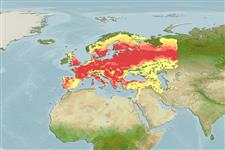分類 / Names
Common names from other countries
主要參考資料
大小 / 重量 / 年齡
Max length : 70.0 cm SL 雄魚/尚未辨別雌雄; (Ref. 44894); common length : 20.0 cm TL 雄魚/尚未辨別雌雄; (Ref. 556); 最大體重: 7.5 kg (Ref. 556)
Length at first maturity
Lm ?, range 20 - ? cm
環境
; 淡水; 半鹹淡水 居於水底的; 河川洄游 (Ref. 51243); 深度上下限 1 - ? m (Ref. 26368)
氣候 / 範圍
4°C - 24°C (Ref. 13614), preferred ?; 64°N - 36°N, 10°W - 104°E
分布
Eurasia: hypothesized as native in most Europe, naturally absent only in Ireland, Scandinavia north of 61°30'N, eastern Adriatic basin and western and southern Greece where it is now introduced. In Asia, native eastward to western Yenisei drainage south of 60° N. Introduced elsewhere.
國家 | FAO區域 | 生態系 | 發現紀錄 | 簡介
簡短描述
背棘 (總數): 4; 背的軟條 (總數): 8-9; 臀棘 3-4; 臀鰭軟條: 6 - 8; 脊椎骨: 39 - 41. Body thickset, heavy, and laterally compressed, the caudal peduncle characteristically deep and short. Skin thickened, slimy; the scales small, embedded. Overall coloration olive-green, at times dark green or almost black, with golden reflections on ventral surface. Head triangular, eye orange-red, small; snout relatively long; interorbital broad; mouth terminal, small in size with thick lips and a pair of well-developed barbels, one at each corner of the mouth. Caudal fin with 19 rays (Ref. 2196). Diagnosed from other cyprinid species in Europe by the following characters: body golden greenish brown; one pair of barbel (maxillary); lateral line with 96-115 scales, small and deeply embedded; dorsal fin with 8-9½ branched rays; and anal fin with 6-9½ branched rays (Ref. 59043).
人類使用
漁業: 商業性; 養殖: 商業性; 游釣魚種: 是的; 水族館: 公眾的水族館
工具
特別的報告
下載 XML
網路資源
Estimates of some properties based on models
Phylogenetic diversity index
PD50 = 1.0000 many relatives (e.g. carps) 0.5 - 2.0 few relatives (e.g. lungfishes)
營養階層
3.7 ±0.0 se; Based on diet studies.
回復力
中等的, 族群倍增時間最少 1.4 - 4.4年 (tm=2; tmax=10; Fec=120,000-800,000)
瀕危性
High vulnerability (65 of 100)
價格種類
